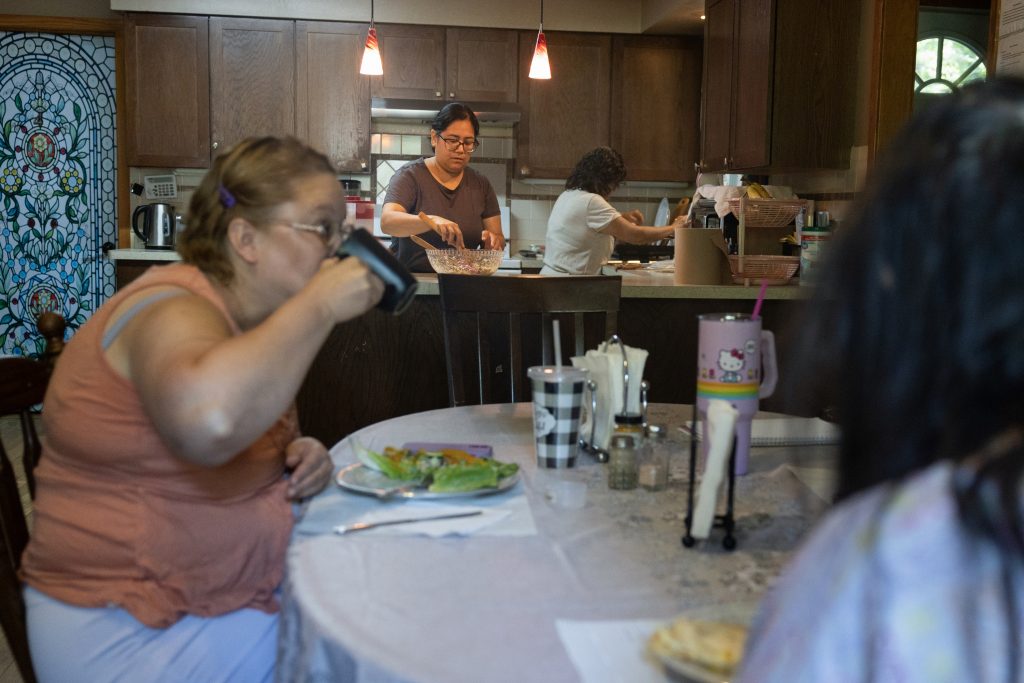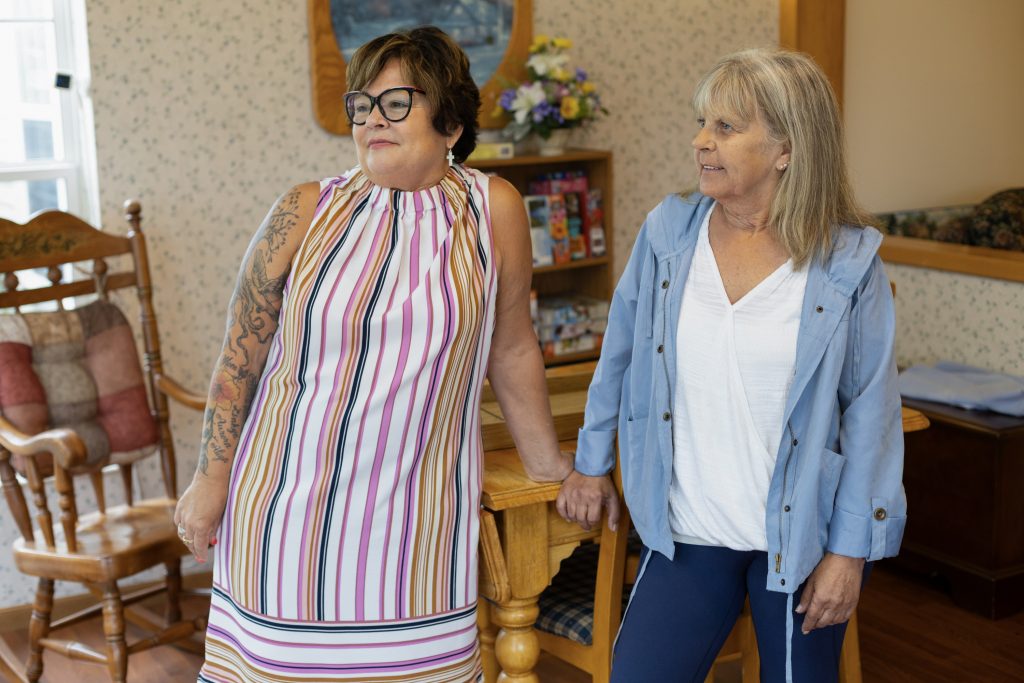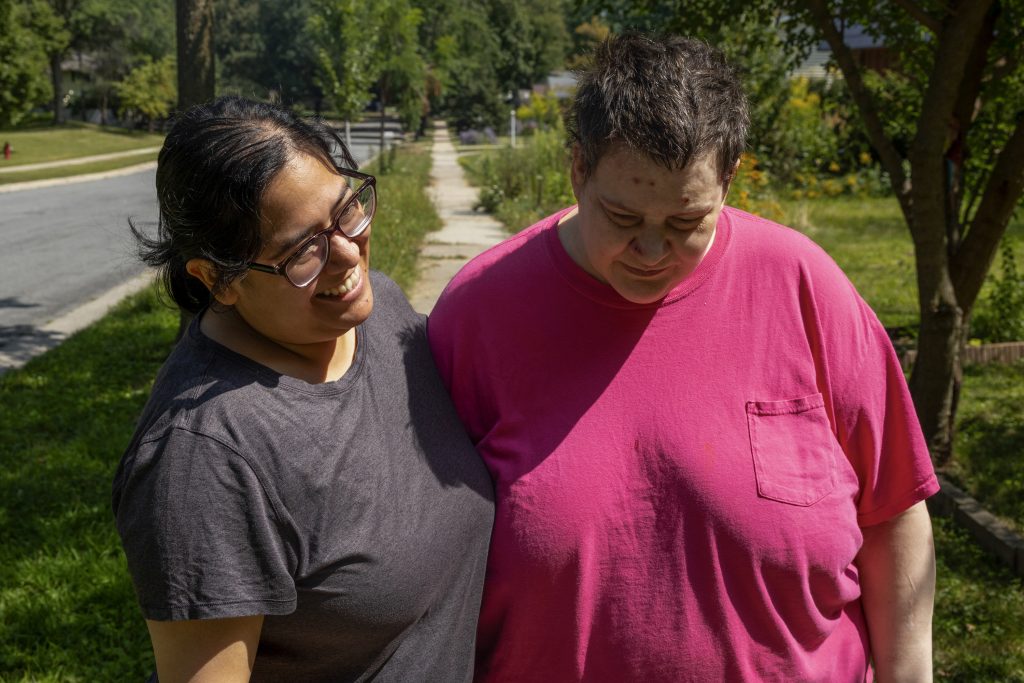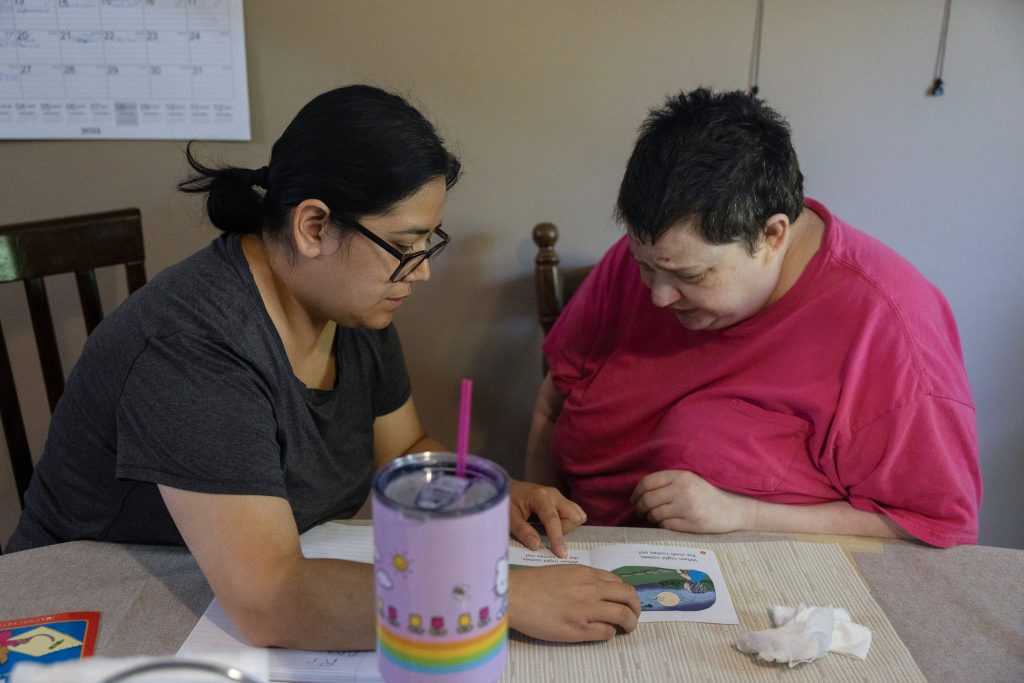Staffing, Medicaid Rates Put Wisconsin’s Long-Term Care Providers in Crisis
Gov. Evers’ $258 million plan will temporarily help, but more needed providers say.

Rosa Landa, owner of Good Hand Care AFH, second from left, makes lunch for the facility’s residents on Aug. 23, 2024, in Madison, Wis. Landa considered closing the facility before a slight Medicaid reimbursement hike allowed the home to survive. (Joe Timmerman / Wisconsin Watch)
This story was produced and originally published by Wisconsin Watch, a nonprofit, nonpartisan newsroom, and was co-published with WPR and Isthmus, an independent, local news source based in Madison. It was made possible by donors like you.
Barbara Hendricks needs at least 10 residents to pay out of pocket for her 22-bed assisted living facility in Horicon, Wisconsin to survive.
“We will just make it,” Hendricks said.
Squeezing by required Hendricks to close the other assisted living facility she ran in Waupun. The decision to close by August left the city with no assisted living providers for seniors who rely on government funding after exhausting their savings. The facility sits empty after the closure forced 12 residents to find new homes, an increasingly difficult task for seniors already on Medicaid, the joint state and federal aid program to help low-income residents afford care.
“Going to see the residents now you can see they’re sad. They’re not home,” Hendricks said. “They’re just not home.”

Barbara Hendricks, owner of Marvin’s Manor, an assisted living facility, stands to the left of her assistant Terri Uherka on Aug. 15, 2024, in Horicon, Wis. Hendricks previously owned an assisted living facility in Waupun. It closed in August due to budget pressures. (Joe Timmerman / Wisconsin Watch)
Assisted living has grown in popularity across Wisconsin and the country, offering aging residents and people with disabilities more independence in less institutionalized settings than traditional nursing homes. But providers continue to struggle. Low state reimbursement rates through Medicaid have depressed provider revenue and worker pay.
That has led some facilities to oust residents who rely on government assistance or even close, limiting options for residents in need.
In 2023 alone, 148 Wisconsin assisted living communities closed voluntarily, according to the Wisconsin Department of Health Services.
A Jefferson County provider cited “the historic and compounding gap between government long-term care provider reimbursement rates and the costs associated with providing care — in particular wages” as the biggest factor in its deficit.
The owner of a shuttered Green County facility wrote simply: “NO STAFF TO WORK.”
The state has incrementally boosted Medicaid reimbursement rates to cover assisted living and home health care, but not every provider benefited, and the rates continue to lag behind the cost of care.
Democratic Gov. Tony Evers in August directed the state health department to spend more than $250 million in federal pandemic relief on assisted living. That was after the Republican-led Legislature’s budget writing committee blocked an earlier plan in an ongoing struggle over spending power.
Long-term care experts say Evers’ action will help, but only temporarily, and it still falls short of the full cost of care.
The emergency dollars must be spent by June 2025.
The Legislature will then decide whether to keep the funding in the state’s two-year budget. Republican leaders have previously called the rate increases too expensive.
“I don’t think (state officials) understand it,” Hendricks said. “They don’t see it. They don’t live it. We do.”

Rosa Landa, owner of Good Hand Care AFH assisted living facility, left, laughs with resident Bebette Gaus upon finishing a walk around the neighborhood on Aug. 23, 2024, in Madison, Wis. (Joe Timmerman / Wisconsin Watch)
Providers seek relief
Wisconsin since 2020 has increased its average monthly Medicaid payments by roughly $790 per care recipient. But not every provider has seen recent raises.
Reimbursement rates for some of Hendricks’ residents haven’t budged in five years, said her daughter Tonya Maldonado, who handles billing for the company.
How is that possible? Managed care.

The dining room inside Marvin’s Manor, an assisted living facility in Horicon, Wis., is shown on Aug. 15, 2024. (Joe Timmerman / Wisconsin Watch)
The state doesn’t reimburse providers directly. It pays managed care organizations, which negotiate rates with providers, aiming to limit costs. Wisconsin’s four MCOs later pay providers.
Managed care systems intend to provide higher value care to Medicaid recipients for less money, said Vincent Pohl, a senior researcher at Mathematica, a social policy research firm.
Managed care companies want to keep their costs low and maximize profits by passing as little Medicaid funding to providers as possible, Pohl said. They are navigating tough economics themselves, and historically low state reimbursement rates have left them little room to pass more money to providers, said Rene Eastman, vice president of financial and regulatory services at LeadingAge Wisconsin.
“Under federal rules, there are very few ways in which the department can direct a managed care organization to spend its money,” said Wisconsin Medicaid Director Bill Hanna.
But the state can set minimum Medicaid reimbursement rates for MCOs to send providers, Hanna said. It has done so for nursing homes and other forms of medical care, but assisted living facilities have long lacked such assurance.
Evers’ pandemic relief plan sets aside $258 million to increase Medicaid reimbursements. Unlike previous increases, it guarantees minimum payments to providers.
Nearly two-thirds of assisted living providers will see a more than 40% increase to their reimbursement rates, the Department of Health Services estimates. Three-fourths of supportive home care services would see a more than 16% increase, showing that most providers are currently getting less from MCOs.
Hanna said some providers see the plan as a lifeline.
“I got phone calls the day of the announcement, from providers who called and said, ‘We were about to tell our board we needed to start closing procedures, but because of the minimum fee, we’re able to stay open,’” he said.

Pillows and flowers decorate the sunroom at Marvin’s Manor, an assisted living facility in Horicon, Wis., on Aug. 15, 2024. (Joe Timmerman / Wisconsin Watch)
Susan Osteen, president and CEO of Diverse Options in Fond du Lac County, hasn’t yet felt relief.
“Whenever the state does something like this, we always just wait and see what’s coming next,” Osteen said. “And I don’t know what that’s going to mean for us.”
Osteen says she’s waiting to see where the state sets minimum rates.
A reimbursement hike previously blocked by lawmakers would have required MCOs to reimburse providers at a $15.75 hourly wage for caregivers, up from the current $13.02 per hour. Britt Cudaback, an Evers spokesperson, said the governor’s latest proposal matched the previous plan.
The hike would still fall short of the $18 to $22 per hour wages Osteen pays employees.
Meanwhile, some providers worry the minimum reimbursement rates will become ceilings in practice — with no motivation for MCOs to pay more competitive rates, said Janet Zander, advocacy and public policy coordinator with the Greater Wisconsin Agency on Aging Resources, Inc.
“Even those that are lifted, will they be lifted high enough to truly change the course that we’re experiencing now?” Zander asked.
Little room for error
Rosa Landa bought her first assisted living home in 2019, starting with just two residents in the Madison facility. With particularly low Medicaid reimbursement rates at the time, she dipped into her own savings to keep the home running — even before she had additional staff to pay.
She considered closing Good Hand Care AFH before a slight Medicaid reimbursement hike allowed the home to survive and higher demands filled all four of its rooms.
Landa and her family take on most of the work alongside two employees. Their business turns a modest profit, but still-low Medicaid reimbursement rates offer little wiggle room.
She and her husband opened a new home in Monona at the start of this year. So far, the new home only has one resident, leaving three of its four rooms sitting empty. Although more residents plan to move into the home soon, Landa can’t help worrying.
“I cannot breathe basically, until I see everybody in the house,” said Landa, who hadn’t heard about Evers’ $258 million plan.

Rosa Landa, owner of Good Hand Care AFH assisted living facility, left, reads a book with Bebette Gaus on Aug. 23, 2024, in Madison, Wis. Gaus has lived at the facility for three years. (Joe Timmerman / Wisconsin Watch)
The state health department will hold a webinar for providers in a month or two, Hanna said, and it will implement new rates by Oct. 1. All providers should start benefiting from the new rates by early 2025.
But the change could be short-lived.
Continuing the higher rates after June would cost the state and federal governments an estimated $516 million over two years, adding to Wisconsin’s roughly $30 billion biennial Medicaid budget. The Department of Health Services will request the increase in the next budget cycle.
While the department can set minimum rates on its own, the Legislature controls the funding to make it viable.
A member of the Republican-controlled Joint Committee on Finance blocked the minimum rate from implementation in April. Committee leaders say they worry about the annual cost of maintaining higher rates once pandemic relief runs out.
“Just nine months ago, the Joint Committee on Finance approved nearly half a billion dollars in new money to support the long-term care industry in our state, bringing our total new investment in the past three budgets to well over a billion dollars,” committee co-chair Rep. Mark Born, R-Beaver Dam, wrote in a statement.
The state allocated more than half of new long-term care investments to nursing homes rather than assisted living facilities or at-home care, according to a WPR and Wisconsin Watch analysis of the past three state budgets.
But more than 90% of Wisconsin Medicaid recipients received long-term care outside of nursing homes or other institutional settings, according to an analysis of 2020 data by KFF, a health policy research firm.
It’ll be hard on the providers if the Legislature does not extend the rate increases from Evers’ plan — especially for those who raise employee wages with the extra funding, Eastman of LeadingAge Wisconsin said.
“Once a caregiver wage is increased it’s extremely difficult and morally impossible to take that away,” Eastman said. “Providers need to be reassured that higher reimbursement will continue so that they can continue to pay their employees a fair and living wage.”
Jack Kelly of Wisconsin Watch contributed reporting.
If you think stories like this are important, become a member of Urban Milwaukee and help support real, independent journalism. Plus you get some cool added benefits.

















